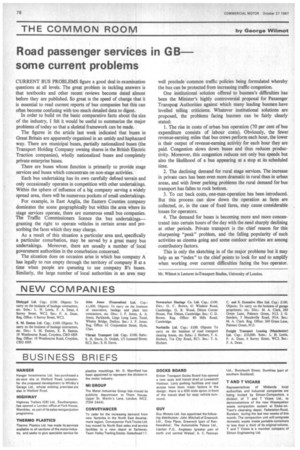Road passenger services in GB some current problems
Page 80

If you've noticed an error in this article please click here to report it so we can fix it.
CURRENT BUS PROBLEMS figure a good deal in examination questions at all levels. The great problem in tackling answers is that textbooks and other recent reviews become dated almost before they are published. So great is the speed of change that it is essential to read current reports of bus companies but this can often become confusing with too much detailed data to digest.
In order to build on the basic comparative facts about the size of the industry, I felt it would be useful to summarize the major problems of today so that a skeletal framework can be made.
The figures in the article last week indicated that buses in Great Britain are apparently organized in an untidy and haphazard way. There are municipal buses, partially nationalized buses (the Transport Holding Company owning shares in the British Electric Traction companies), wholly nationalized buses and completely private enterprise buses.
There are buses whose function is primarily to provide stage services and buses which concentrate on non-stage activities.
Each bus undertaking has its own carefully defined terrain and only occasionally operates in competition with other undertakings. Within the sphere of influence of a big company serving a widely spread area, there will be numerous pockets of small undertakings.
For example, in East Anglia, the Eastern Counties company dominates the scene geographically but within the area where its stage services operate, there are numerous small bus companies. The Traffic Commissioners licence the bus undertakings— granting the right to operate vehicles in certain areas and prescribing the fares which they may charge.
As a result of this situation a particular area and, specifically a particular conurbation, may be served by a great many bus undertakings. Moreover, there are usually a number of local government authorities in the conurbation concerned.
The situation does on occasion arise in which bus company A has legally to run empty through the territory of company B at a time when people are queueing to use company B's buses. Similarly, the large number of local authorities in an area may well preclude common traffic policies being formulated whereby the bus can be protected from increasing traffic congestion.
One institutional solution offered to busmen's difficulties has been the Minister's highly controversial proposal for Passenger Transpott Authorities against which many leading busmen have levelled telling criticisms. Whatever institutional solutions are proposed, the problems facing busmen can be fairly clearly stated: 1. The rise in costs of urban bus operation (70 per cent of bus expenditure consists of labour costs). Obviously, the fewer revenue-earning miles that bus crews perform each hour, the lower is their output of revenue-earning activity for each hour they are paid. Congestion slows down buses and thus reduces productivity. Moreover, this congestion reduces not only bus speeds but also the likelihood of a bus appearing at a stop at its scheduled time.
2. The declining demand for rural stage services. The increase in private cars has been even more dramatic in rural than in urban areas, and with fewer parking problems the rural demand for bus transport has fallen to rock bottom.
3. To cut back costs, one-man-operation has been introduced. But this process can slow down the operation as fares are collected, or, in the case of fixed fares, may cause considerable losses for operators.
4. The demand for buses is becoming more and more concentrated into certain hours of the day with the need sharply declining at other periods. Private transport is the chief reason for this sharpening, "peak" problem, and the falling popularity of such activities as cinema going and some outdoor activities are among contributory factors.
This is only the sketching in of the major problems but it may help as an "index" to the chief points to look for and to amplify when working over current difficulties facing the bus operator.






















































































































